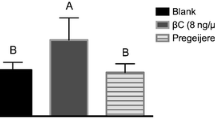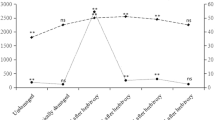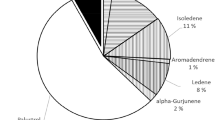Abstract
The role of airborne infochemicals in host selection by the parasitoidCotesia rubecula (Marshal) (Hymenoptera: Braconidae) was examined in a wind tunnel. To elucidate the role of volatile chemicals in attractingC. rubecula to cabbage infested by the host [Pieris rapae L. (Lepidoptera: Pieridae)], the potential sources of volatiles related toP. rapae infestation on cabbage were tested individually. The responses of females to nonhost plant species, bean and geranium, as well as to frass of a nonhost lepidopteran were also examined.C. rubecula was attracted to cabbage previously infested byP. rapae and to frass and regurgitate ofP. rapae. No attraction was observed to larvae ofP. rapae alone. Females were also attracted to mechanically damaged cabbage, cabbage previously infested byPlutella xylostella L. (Lepidoptera: Plutellidae) (a nonhost lepidopteran herbivore), and cabbage previously infested by snails (a nonhost, noninsect herbivore). Intact cabbage, bean, and geranium plants elicited no attraction. A low frequency of attraction was observed to mechanically damaged bean and geranium. Attraction was also observed to frass ofP. xylostella. Volatiles from cabbage related to damage, and volatiles from frass and regurgitate of the host seem to play an important role in guidingC. rubecula to plants infested by its host.
Similar content being viewed by others
References
Agelopoulos, N.G., andKeller, M.A. 1994. Plant-natural enemy association in the tritrophic systemCotesia rubecula-Pieris rapae-Brassicaceae (Cruciferae). II. Preference ofC. rubecula for landing and searching.J. Chem. Ecol. 20:1735–1748.
Biever, K.D. 1992. Distribution and occurrence ofCotesia rubecula (Hymenoptera: Braconidae), a parasite ofArtogeia rapae in Washington and Oregon.J. Econ. Entomol. 85:739–742.
Cole, R.A. 1980. Volatile components produced during ontogeny of some cultivated Crucifers.J. Sci. Food Agric. 31:549–557.
Dicke, M., andTakabayashi, J. 1991. Specificity of induced indirect defence of plants against herbivores.Redia 17(3)Appendix: 105–113.
Dicke, M., Van Beek, T.A., Posthumus, M.A., Ben Dom, N., Van Bokhoven, K.L., andDe Groot, T.A.E. 1990a. Isolation and identification of volatile kairomone that affects acarine predator-prey interactions: Involvement of host plant in its production.J. Chem. Ecol. 16:381–398.
Dicke, M., Sabelis, M.W., Takabayashi, J., Bruin, J., andPosthumus, M.A. 1990b. Plant strategies of manipulating predator prey interactions through allelochemicals. Prospects of application in pest control.J. Chem. Ecol. 16:3091–3118.
Eller, E.J., Tumlinson, J.H., andLewis, W.J. 1988. Beneficial behavior mediated by airborne semiochemicals: Source of volatiles mediating the host location flight behavior ofMicroplitis croceipes (Cresson) (Hymenoptera: Braconidae), a parasitoid ofHeliothis zea (Boddie) (Lepidoptera: Noctuidae).Environ. Entomol. 17:745–753.
Elzen, G.W., Williams, H.L., Vinson, S.B., andPowell, J.E. 1987. Comparative flight behavior of parasitoidCampoletis sonorensis andMicropolitis croceipes.Entomol. Exp. Appl. 45:175–180.
Elzen, G.W., Williams, H.L., andVinson, S.B. 1983. Responses by the parasitoidCampoletis sonorensis (Hymenoptera: Ichneumonidae) to chemicals (synomones) in plants: Implications for host habitat location.Environ. Entomol. 12:1873–1877.
Kaiser, L., andCardé, R.T. 1992. In-flight orientation to volatiles from the plant-host complex inCotesia rubecula (Hym.: Braconidae): Increased sensitivity through olfactory experience.Physiol. Entomol. 17:62–67.
Keller, M.A. 1990. Responses of the parasitoidCotesia rubecula to its hostPieris rapae in a flight tunnel.Entomol. Exp. Appl. 57:243–249.
Lewis, W.J., andJones, R.L. 1971. Substance that stimulates host-seeking byMicroplitis croceipes (Hymenoptera: Braconidae) a parasite ofHeliothis species.Ann. Entomol. Soc. Am. 64:471–473.
Loke, W.H., Ashley, T.R., andSailer, R.J. 1983. Influence of fall army worm,Spodoptera frugiperda (Lepidoptera: Noctuidae) larvae and corn plant damage on host finding inApanteles magriniventris (Hymenoptera: Braconidae).Environ. Entomol. 12:911–915.
Navasero, R.C., andElzen, G.W. 1989. Responses ofMicroplitis croceipes to host and non-host plants ofHeliothis virescens in a wind tunnel.Entomol. Exp. Appl. 53:57–63.
Nealis, V. 1986. Responses to host kairomones and foraging behavior of the insect parasiteCotesia rubecula (Hymenoptera: Braconidae).Can. J. Zool. 64:2393–2398.
Nealis, V. 1990. Factors affecting the rate of attack byCotesia rubecula (Hymenoptera: Braconidae).Ecol. Entomol. 15:163–168.
Roland, J. 1990. Parsitoids aggregation: Chemical ecology and population dynamics, pp. 185–211,in M. Mackauer, L. Eller, and J. Roland (eds.), Critical Issues in Biological Control. Intercept Ltd, Andover, England.
Shenefelt, R.D. 1972. Braconidae 4, Microgasterinae, Apanteles, p. 615,in J. Van Der Vecht and R. Shenefelt (eds.), Hymenopterum Catalogus, Vol. 7, W. Junk, The Hague, Netherlands.
Silsbury, J.H. 1984. Comparison of the growth rates of dinitrogen fixing subterranean clovers swards with those assimilating nitrate ions.Plant Soil 80:201–213.
Turlings, T.G.J., Tumlinson, J.H., andLewis, W.J. 1990. Exploitation of herbivore-induced plant odours by host-seeking parasitic wasps.Science 250:1251–1253.
Turlings, T.G.J., Tumlinson, J.H., Eller, F.J., andLewis, W.J. 1991. Larval-damaged plants: Source of volatile synomones that guide the parasitoidCotesia marginivetris to the microhabitat of its hosts.Entomol. Exp. Appl. 58:75–82.
Vet, L.E.M., andDicke, M. 1992. Ecology of infochemicals used by natural enemies in a tritrophic context.Annu. Rev. Entomol. 37:141–172.
Vinson, S.B. 1984. How parasitoids locate their hosts: A case of insect espionage, pp. 325–348,in T. Lewis (ed.). Insect Communication. Academic Press, New York.
Wallbank, B.E., andWheatley, G.A. 1976. Volatile constituents from cauliflower and other crucifers.Phytochemistry 15:763–766.
Whitman, D.W., andEller, F.J. 1990. Parasitic wasps orient to green leaf volatiles.Chemoecology 1:69–75.
Wilkinson, A.T.S. 1966.Apanteles rubecula Marsh. and other parasites ofPieris rapae in British Columbia.J. Econ. Entomol. 59:1012–1013.
Wilkinson, D.S. 1945. The late D.S. Wilson's description ofApanteles rubecula Marsh.Trans. R. Entomol. Soc. London 95:35–226.
Wilson, F. 1960. A review of the biological control of insects and weeds in Australia and Australian New Guinea. Tech. Commun. 1:CAB30–31.
Author information
Authors and Affiliations
Rights and permissions
About this article
Cite this article
Agelopoulos, N.G., Keller, M.A. Plant-natural enemy association in the tritrophic system,Cotesia rubecula-Pieris rapae-brassiceae (cruciferae): I. Sources of infochemicals. J Chem Ecol 20, 1725–1734 (1994). https://doi.org/10.1007/BF02059894
Received:
Accepted:
Issue Date:
DOI: https://doi.org/10.1007/BF02059894




